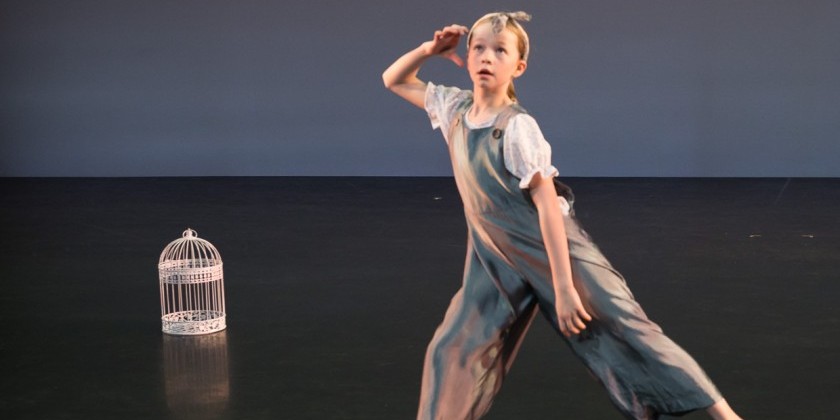IMPRESSIONS: Back to the Futurism: Bill T. Jones/Arnie Zane Company in "Curriculum ll" at New York Live Arts

Conceived and directed by Bill T. Jones
Choreography by Bill T. Jones with Janet Wong and the Company
Lighting design by Robert Wierzel
Video Design by Janet Wong
Sound Design by David van Tieghem
Installation and costume design by Liz Prince
Additional sound scape work by Shane Larson
Featuring Barrington Hinds, Jana Jenai, Shane Larson, s.lumbert, Danielle Marshall, Marie Lloyd Paspe, Jacoby Pruitt, Nayaa Opong, Philp Strom, and Huiwang Zhang
Like many people today, choreographer Bill T. Jones has conflicted feelings about technology and humanity’s future. His confidence and his doubts become apparent during Curriculum II, a wild excursion to the borderlands of science that the Bill T. Jones/Arnie Zane Company revived on October 4, opening the fall season at New York Live Arts. In Curriculum II, Jones and his collaborators take us for a 70-minute ride into theatrical hyperspace, where we can contemplate our past and our potential side-by-side.
Wonderfully stimulating, this 2022 creation is a collage displaying multiple techniques; and it comes packed with timely ideas. Video images and digital signage combine with dancing, singing, and the spoken word to produce a kind of musical TED talk, in which Shane Larsen acts as lecturer and guide. The whole is set within a provocative installation by Liz Prince, who also designed the costumes.

Like the world we live in, this mise-en-scène is complicated and threatening. The audience enters through a basement corridor splashed with red paint, like blood, which seems to dye small flowers lining the way. Taking seats on the edge of the stage, we notice a corner in which the skeletons of a human and a small dog lie beneath a display of American flags. Did these unfortunates perish crawling toward the American Dream? Hangman’s nooses appear in frames. Video screens lie askew amid the seats of the auditorium on one side.
Jones has his eyes raised to the heavens, however, so the piece begins with screen images of stars and of the lunar surface. Marie Lloyd Paspe sings a charming ‘60s tune, “Everyone’s Gone to the Moon,” and the dancers, who were clustered together, spread out and begin to spin, each one revolving in the light of a smartphone. We hear a passage from Genesis---the part about being fruitful and multiplying---and then Jones proposes a series of labels. “Human” or “non-human” are offered first; and we must decide how the terms “transhuman,” “post-human,” and “primitive people” fit into those categories.

Where have we heard this before? Oh, yes. It’s the discriminatory language of racism and class conflict projected into an imagined future in which some of us will have the latest upgrades to our neural implants, while others go without. Is there any doubt this future is coming? Will those of us who have gratefully accepted contact lenses, pacemakers, vaccines, and those ubiquitous mobile phones, pause for even an instant before we move on to designer babies grown in tanks, and the ultimate convenience of an implant? Just think of being able to search the Internet for government-approved content merely by blinking your startled eyes!
Jones knows something like this will happen. He has been reading Nathaniel Rich (Second Nature: Scenes from a World Remade) and Loui Chude-Sokey (The Sound of Culture: Diaspora and Black Technopoetics). “The unthinkable seems to be happening daily,” we are told. And can we doubt that in the soon-to-be transhumanist future, the old hatreds and the violence will continue as some of us are deemed less human than others? It may be hard to convince Jones otherwise. He has, in fact, discovered the potential for discrimination against post-humans in the awful story of Joice Heth, an enslaved African-American woman whom P.T. Barnum exhibited as a “curiosity” in 1835, claiming she was 161 years old. A suspicious patron (we’re gullible, but not that gullible) seems to have written a letter accusing Barnum of exhibiting an automaton like Maelzel’s Chess Player, rather than a living woman; and, voilà, we have our first recorded case of trans-post-robo-phobia, or whatever the prejudice against bionic people will be called someday, when the script of Blade Runner becomes reality. Prepare for blood, and possibly motor oil, to be shed.

And yet… There’s something hopeful in the DNA of Curriculum II. Despite all the digital bells & whistles, this piece remains a live spectacle powered by human beings, not AI. It could never be digitized, because the intimacy of the space and the physicality of the dancers, who rest on vacant seats beside us, whose movements stir the air around us, and who ultimately shed their clothes to reveal their gloriously youthful bodies, are central to our experience of this work. Although the dancers transform themselves with body paint, daubing themselves with bright colors, they remain supremely human and we can take pride in belonging to the same species.
Duets — primal encounters with an Other — seem especially significant in Curriculum II. Nayaa Opong and Jada Jenai face off. Taking tentative steps, they mirror each other delicately. Closing in and bending forward, side-by-side, they grasp each other’s feet. Yet they seem most intimate when sitting apart and gazing at each other with a frank expression that suggests they know each other well. Later, Huiwang Zhang and Barrington Hinds have a more violent encounter that begins with an attack, but then softens as Zhang traces the outline of Hinds’ body with one hand. Solos also emerge from the matrix of the ensemble, notably Hinds’ dance as a lumbering Caliban figure, alternately trembling and aggressive; Philip Strom in a flailing, hyperactive dance that animates the red-white-and-blue ribbons of his costume; and Opong stalking like a runway model on half-toe, her body painted silver. There will never be a substitute for the humanity of these performers.

Jones’ answer to the sung question, “Have we lost the human touch?” is a resounding “No!” And good luck getting AI to match the talent of an artist like Nina Simone; to give birth to a musical genre like the Blues; or to put a lifetime of emotional experience into the wary voice of an old man. Curriculum II proves that technological mimicry is not creativity. Here it also may be worth recalling that Bill T. Jones was one of the first choreographers to experiment with Motion Capture technology, in his solo program The Breathing Show (2000). The lesson to emerge was that even stripped of his flesh and reduced to a schematic outline on a screen, Jones did not lose his distinctive movement quality or his power as a dancer. Art, and particularly dance, cannot be separated from humanity or from the gifts of an individual artist.

Much more could be said about Curriculum II and the issues it raises. We might ask, for instance, if fear of the “uncanny,” of the strange and the taboo, is always racism in another guise. Isn’t it also possible that 19th-century writers like Mary Shelley and ETA Hoffmann were correct in warning us of the danger of technology divorced from morals? In the age of the atomic bomb and bioweapons labs, do we truly have nothing to fear from Frankenscience?
Science did not, and will not protect us from slavery (quite the opposite). Racism does not have a technocratic fix (see, again, Ralph Ellison’s The Invisible Man). Racism and other forms of bigotry are moral problems that can only by solved by expanding the human consciousness we are all born with. As Lewis Mumford pointed out, many years ago, in his book The Myth of the Machine, moral awareness appeared in human culture long before the advent of technology. You don’t have to be a Luddite to believe that our task, as humans, is not to mechanize ourselves but to keep dancing and singing, and grow into a better future.












